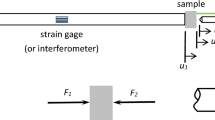Abstract
For Kolsky bar testing beyond strain-rates of 10,000/s, it is useful to employ bars with diameters of only a few millimeters or less. Furthermore, very small (sub-millimeter) systems are compatible with micron-sized specimens, to be used, for example, for the determination of mesoscale properties. However, at these sizes, traditional strain-gage measurements of the longitudinal waves within the bars become impractical. In this paper we describe the application of optical measurement techniques to two Kolsky bars, with 3.2 and 1.6 mm diameters. A transverse displacement interferometer is used to measure the displacement of the mid-point of the incident bar and provide measurements of the incident and reflected pulses. Similarly, a normal displacement interferometer is used to measure the displacement of the free-end of the transmitter bar and provide a measurement of the transmitted pulse. The new methods are used to characterize the behavior of 6061-T6 aluminum at rates greater than 100,000/s. The feasibility of application to smaller bars is also discussed.











Similar content being viewed by others
Notes
Stress and strain, whether referring to the specimen or to the bars, are assumed positive in compression.
A bar with a higher wave speed, and/or lower Poisson’s ratio can also be used.
If strain and particle velocity are measured simultaneously at the same location, a simple wave separation method is available, see for example [18].
An expanded beam is used to simplify alignment.
The grating also deforms slightly; this is assumed negligible.
There is also a reflected beam (0th order diffracted beam) that is not used, although it is used as one leg of an NDI in the PSPI application.
It is possible to use a momentum trap and measure its free surface displacement to measure the transmitted pulse, but care must be taken that the trap and transmitter bar do not separate until after the required time window.
[19] has used the fact that the free-end is stress-free for wave separation in a strain-gage instrumented bar.
In general, the strain-rate of the specimen is not constant during a Kolsky bar experiment. The reported rates are the true strain-rates at 10% true strain.
References
Kolsky H (1949) Proc Phys Soc B 62:676–700
Follansbee PS (1985) “The Hopkinson Bar,” Metals Handbook, 8 (9), American Society for Metals, Metals Park, OH, pp 198–217
Gorham DA (1983) A numerical method for the correction of dispersion in pressure bar signals. J Phys E Sci Instrum 16:477–479
Follansbee PS, Franz C (1983) Wave propagation in the Split-Hopkinson Pressure Bar. J Eng Mat Tech 105:61
Gong JC, Malvern LE, Jenkins DA (1990) Dispersion investigation in the Split-Hopkinson Pressure Bar. J Eng Mat Tech 112:309–314
Davies ED, Hunter SC (1963) The dynamic compression testing of solids by the method of the Split-Hopkinson Pressure Bar. J Mech Phys Solids 11:155
Ames RG (2005) “Limitations of the Hopkinson Pressure Bar for High-Frequency Measurements. In: Furnish MD, Elert M, Russell TP, White CT (eds) Shock compression of condenser matter, pp. 1233–1237
Casem DT (2009) “A Small Diameter Kolsky bar for High-rate Compression,” Proc. of the 2009 SEM Annual Conference and Exposition on Experimental and Applied Mechanics, Albuquerque, NM, June 1–4, 2009
Gorham DA (1979) “Measurements of Stress-Strain Properties of Strong Metals at Very High Rates of Strain,” In: Proc. Conf. on Mech. Prop. at High Rates of Strain, conf. no. 47, Oxford, March 16, 1979
Gorham DA, Pope PH, Field JE (1992) An improved method for compressive stress-strain measurements at very high strain-rates. Proc R Soc Lond A 438:153–170
Safford NA (1992) “Materials testing up to 105/s using a Miniaturized Hopkinson Bar with Dispersion Corrections,” In: Proc. 2nd Intl. Symp. on Intense Dynamic Loading and its Effects, Sichuan UniversityPress, Chengdu, China, p 378
Kamler F, Niessen P, Pick RJ (1995) Measurement of the behavior of high purity copper at very high rates of strain. Can J Phys 73:295–303
Jia D, Ramesh KT (2004) A rigorous assessment of the benefits of miniaturization in the Kolsky Bar system. Exp Mech 44:445–454
Malinowski JZ, Klepaczko JR, Kowalewski ZL (2007) Miniaturized compression test at very high strain rates by direct impact. Exp Mech 47:451–463
Casem DT, Grunschel SE, Schuster BE (2010) “Interferometric Measurement Techniques for Small Diameter Kolsky Bars,” Proc. of the 2010 SEM Annual Conference and Exposition on Experimental and Applied Mechanics, Indianapolis, Indiana, pp. 973–977, June 6–10, 2010
Clifton RJ, Klopp RW (1985) “Pressure-Shear plate impact testing,” Metals Handbook, vol 8, 9th edn. American Society for Metals, Metals Park, OH, pp 230–239
Kim KS, Clifton RJ, Kumar P (1977) Combined normal-displacement and transverse-displacement interferometer with an application to impact of y-cut quartz. J App Phys 48(10):4132–4139
Casem DT, Fourney W, Chang P (2003) “Wave Separation in Viscoelastic Pressure Bars using Single-point Measurements of Strain and Velocity. Polymer Test 22(2)
Park SW, Zhou M (1999) Separation of elastic waves in Split Hopkinson Bars using one-point strain measurements. Exp Mech 39(4):287–294
Bacon C (1998) An experimental method for considering dispersion and attenuation in a Viscoelastic Hopkinson Bar. Exp Mech 38(4):242–249
Johnson GR, Cook WH (1983) “A constitutive model and data for metals subjected to large strains, high strain rates, and high temperatures,” Proceedings of the Seventh International Symposium on Ballistics, The Hague (Netherlands), pp 541–547, 1983
Acknowledgement
This research was supported in part by an appointment to the Postgraduate Research Participation Program at the U.S. Army Research Laboratory administered by the Oak Ridge Institute for Science and Education through an interagency agreement between the U.S. Department of Energy and USARL.
Author information
Authors and Affiliations
Corresponding author
Rights and permissions
About this article
Cite this article
Casem, D., Grunschel, S. & Schuster, B. Normal and Transverse Displacement Interferometers Applied to Small Diameter Kolsky Bars. Exp Mech 52, 173–184 (2012). https://doi.org/10.1007/s11340-011-9524-x
Received:
Accepted:
Published:
Issue Date:
DOI: https://doi.org/10.1007/s11340-011-9524-x




